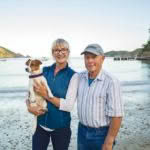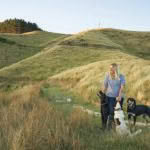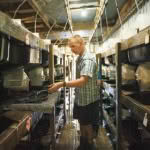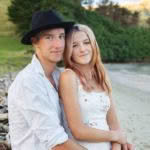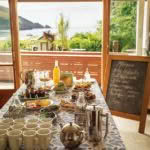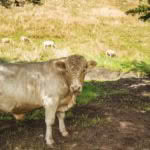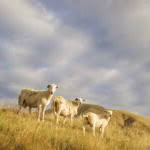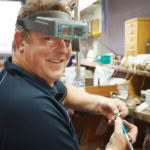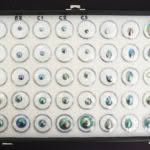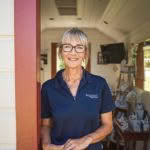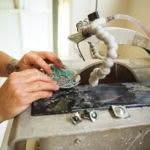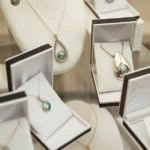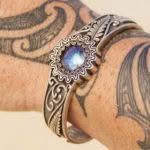Meet the Radon family: Farming pāua and crafting beautiful pearl jewellery in paradise
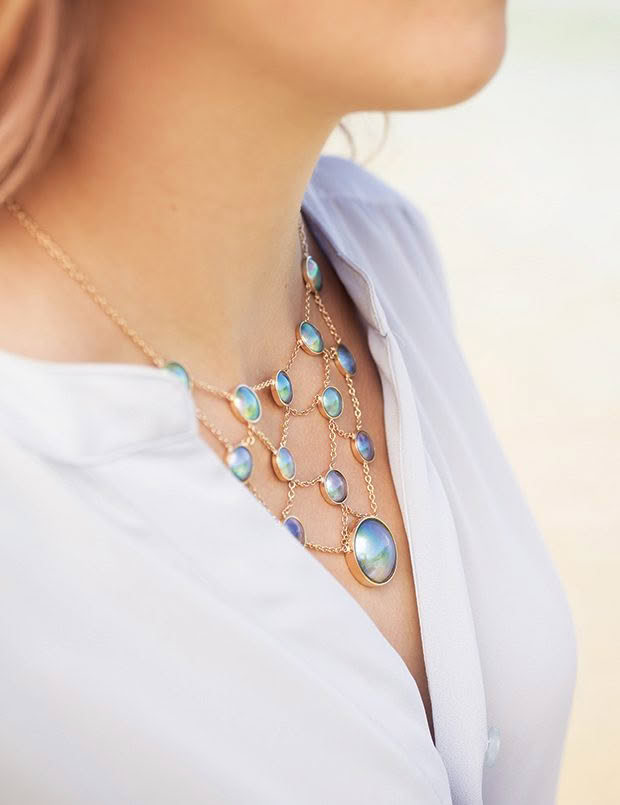
Antonia’s latest design for the Arapawa Blue Pearls is a cascading necklace of 13 blue pearls set in warm gold and modelled by Brooke Fitzgerald, James’ girlfriend.
Antonia and Mike Radon spent many of their early years underwater off California’s coast, harvesting sea urchins and abalone. These days they farm pāua, sheep and cattle, grow pearls, host visitors and sell jewellery to tourists in Whekenui Bay, Marlborough Sounds.
Words: Kate Coughlan Photos: Rachael McKenna
If a Cook Strait ferry were to continue directly ahead after entering Tory Channel, it’d run into an old shed on the beach at Whekenui Bay.
Fortunately for the pāua living a charmed and predator-free life in 200 large tanks inside, the ferry has never missed the sharp port turn up the narrow channel to Picton.
Waves from the vessel wash up the beach outside the wooden building, once pivotal in the pursuit of the largest marine mammals and where the whaling boats were stored. Today it is home to thousands of native abalone (pāua) ranging in size from microscopic spawn, larvae and spat to fully grown gastropod molluscs that scoot about the tanks eating half their body weight in giant kelp every week.
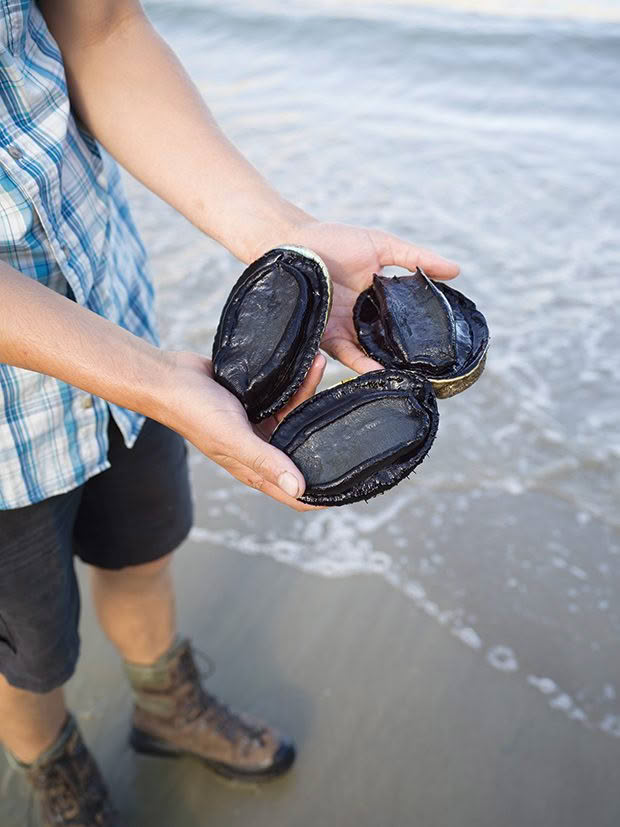
Pāua meat is sent fresh to retailers and restaurants, mostly in Auckland.
Making waves is one of many challenges Mike Radon had to master in developing this successful pāua hatchery — the only hatchery in New Zealand and one of a small number of operations growing the hard-to-rear pāua.
Californian-born Mike tackles life’s obstacles with a “why not?” approach. Why not suspend a row of plastic buckets above the fibreglass tanks and slowly pipe in seawater before gravity takes over to upend 10 litres into the tank below? Mike’s great gushing onslaught of surging and settling seawater is enough like a wave to make the molluscs feel at home. In the Mike-designed tanks, they eat, grow and prepare to breed.
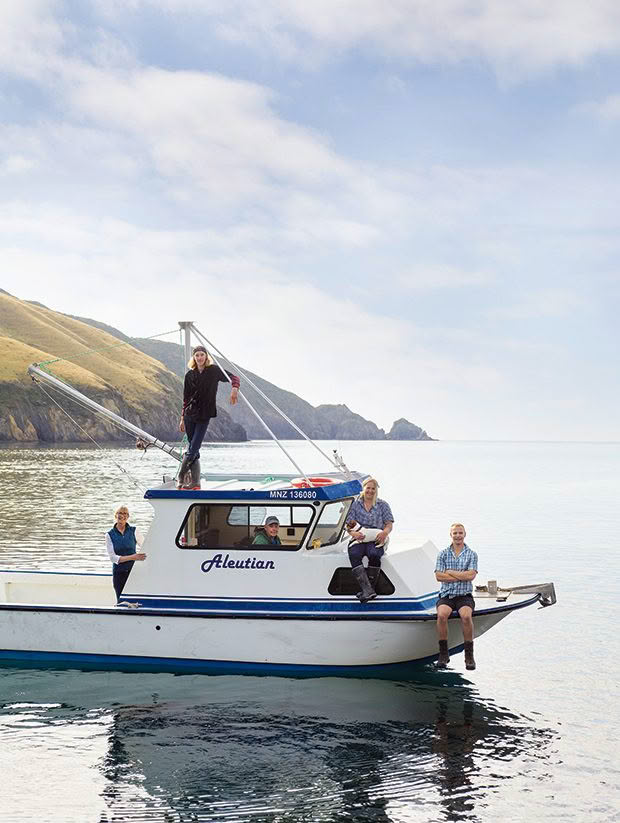
The largest of the Radons’ fleet of boats is the nine-metre Aleutian, designed and built by Mike and the family. In most sea conditions, it makes light work of the 50-minute commute to Picton. (From left): Antonia, James, Mike in the wheelhouse, and twins Sarah (holding puppy, River) and Jacob.
Coaxing them into spawning requires another Mike trick: a dose of hydrogen peroxide to mimic the extra oxygenation of seawater after a violent storm — optimum conditions for marine life to breed.
Dogged, resourceful and entrepreneurial is Mike. At 12, he was convinced he was fully grown up, and by 15, he’d talked his father into building him a boat to join the rest of his family in the commercial fishing industry. The Californian sea urchin industry captured his attention in the 1980s — its gold rush days. Buyers with briefcases bulging with cash sat on the wharf at Fort Bragg, on California’s Mendocino Coast, holding signs offering sea urchin divers “10-30 cents a pound” (50 cents a pound at the height of the market) for their catch. The Japanese sushi market was wild for the mild banana-flavoured delicacy. In 1988, a record 23 million kilogrammes, worth more than $US50 million, were landed in California. By the mid-1990s, the divers were bust, and the fishery had collapsed.
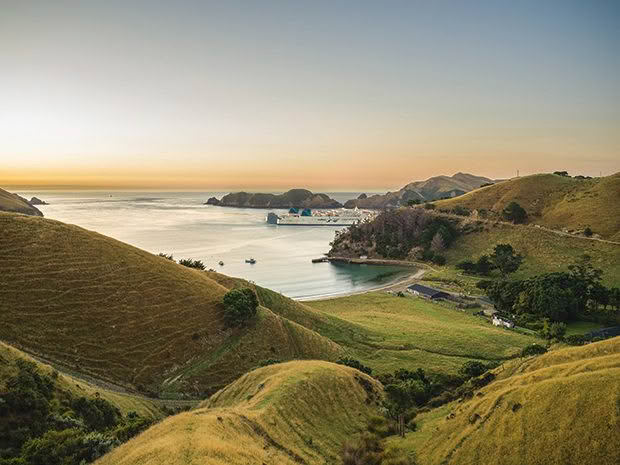
Whekenui Bay was a hub in the Marlborough Sounds whaling industry until the late 1970s. Operations on the island were established by the Perano family, who once stored their whale chasers in the waterfront shed that’s now home to Mike’s pioneering pāua hatchery. Antonia and Mike’s house is also in this sheltered valley (out of shot to the right) with three tourist accommodation options, including the original Perano homestead (called Gunyah), throughout the farm.
Mike’s diving companion was the only woman among the 1100 commercial divers working the Californian seabeds; she’d graduated to diving from cleaning the sea urchins in shoreside factories, often the only non-Mexican on the cleaning line.
“She was a very hard worker and one of the top divers in the whole industry,” Mike says of his wife, Antonia, the New Zealand-born daughter of two psychiatric nurses, who’d left home at 17 for her sister’s wedding in Alaska and stayed on, working as a cook on seiners and in salmon filleting factories. She remains, more than three decades later, a distinguishedly hard worker. It is a family characteristic.
- River, the eight-month-old jack russell descends from a long line of Radon jack russell terriers.
- Sarah has assumed responsibility for the family farming operations, a job she shares with her three dogs.
- Jacob is Mike’s right-hand man in the hatchery.
- James and his partner Brooke, who now lives on the island as part of the family and works across all their jobs.
“In commercial diving, it is the length of time you spend underwater that determines how successful you are, and Mike was a hard worker and a nice guy to work with,” says Antonia, noting how often in her young years in the male-dominated Alaskan and Californian fishing industries, she’d had to work with men who weren’t at all nice.
The pair’s success as commercial divers evolved into romance when they reconnected years later in New Zealand; Mike working pāua quota in the Chathams and Kaikōura and Antonia visiting family.
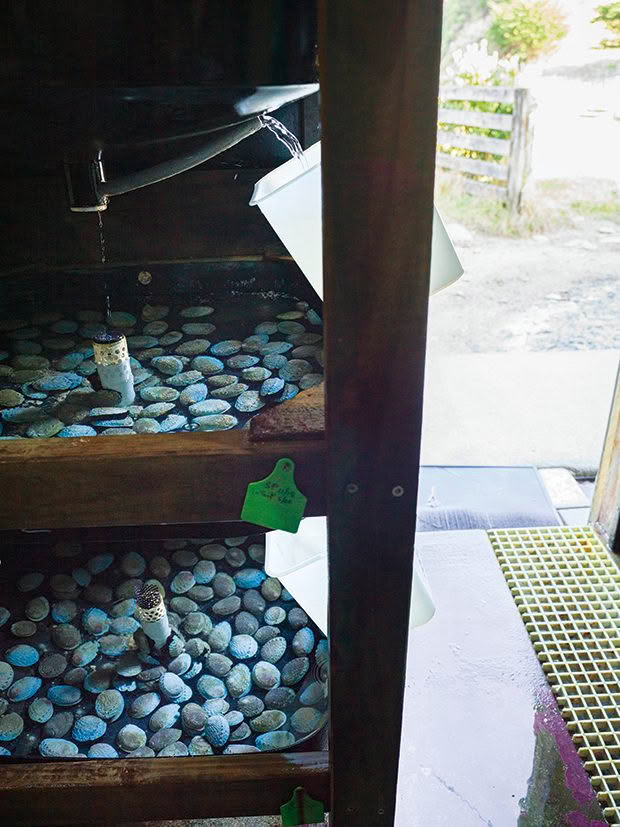
Pāua are grown for four years from microscopic larvae before they are large enough to have the blister inserts put into their shells and over which grows the mabe pearl (known as a blister pearl to differentiate it from a fully round seed pearl.
Mike saw a 900-acre farm (about 350 hectares in the metric world) on remote Arapawa Island — now called Arapaoa Island — in the outer Marlborough Sounds and had to have it. Half a million dollars later, it was his, along with its sheep and cattle. Yet, it was not the land-based creatures that interested him. With land tumbling down to the sea edge on Cook Strait, he was getting closer to his long-held dream of farming abalone.
The following year — 1994 — Mike and Antonia married in the old farm homestead, Gunyah, overlooking Tory Channel and set about bringing their dreams to life. They also created a family of helpful offspring, the now-adult Sarah, Jacob and James, who take significant and individual roles in the diverse business operations at Whekenui Bay.
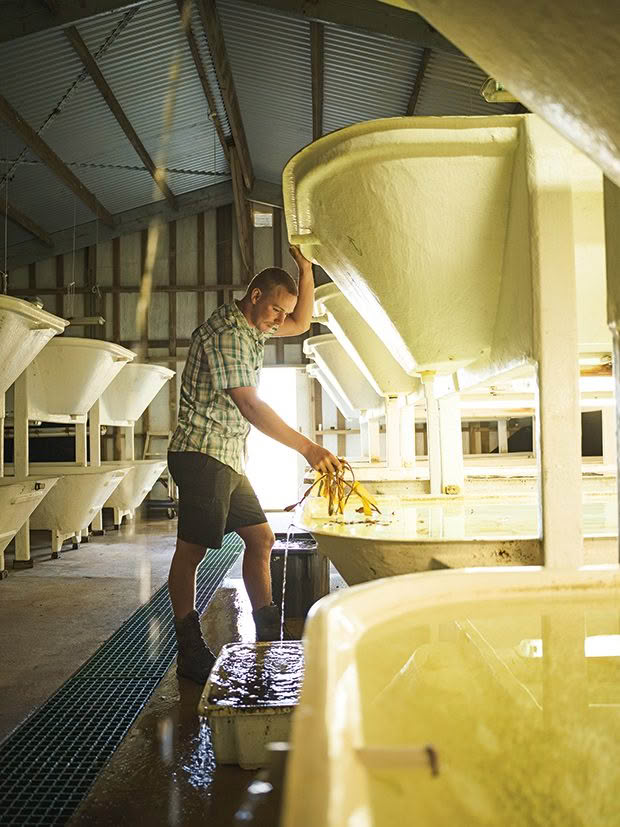
The fibreglass tanks built to Mike’s specification hold the pāua in various stages of growth. The molluscs are fed regularly with giant kelp.
In 2001, Mike excitedly told Antonia the annual accounts showed they’d finally made some money from pāua. “Great,” said the surprised Antonia. “How much?”
“Two dollars, I think,” replied Mike.
The Radon family chases neither short-term goals nor easy money. They’re inclined to value what comes with sweat and effort as they manage the daily challenges of their remote life an hour from Picton by boat.
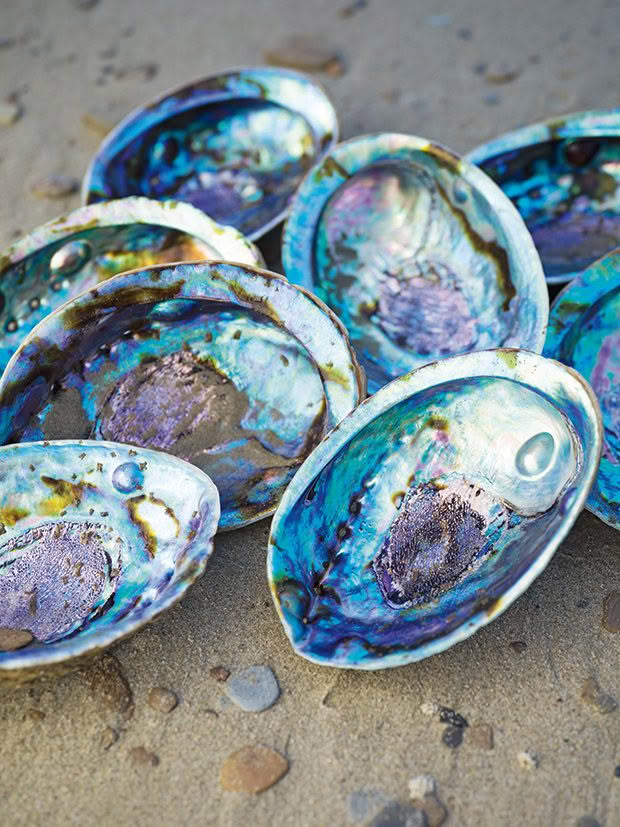
In recent years, Sarah (25) has taken over the farm, managing the cattle and continuing a disciplined cull of any wiltshire sheep not fulfilling the genetic destination to self-shed their wool (no money for shearers in this operation).
Thanks to the money she earned skippering her salmon gillnetter in Alaska (last year a profit of more than US$100,000 or about $160,000 in the two-month-long season), she recently bought a second boat and got her New Zealand skipper’s ticket. It amuses her that in Alaska she owns and skippers a 10-metre salmon gillnetter and employs two crew with no need for a licence. Yet at home, she needs a licence to drive a four-metre boat from which she will free-dive for pāua and gather seaweed.
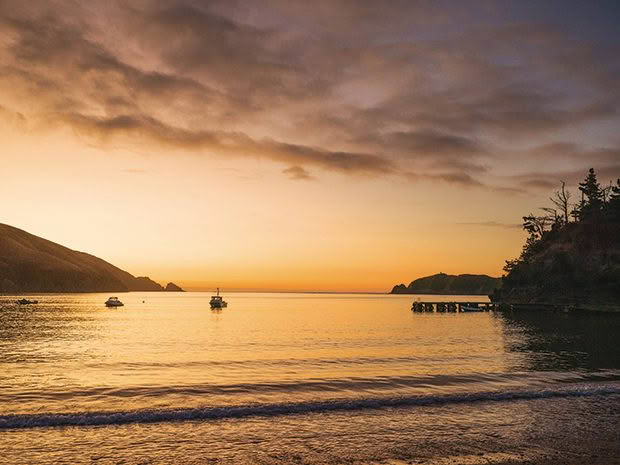
Mike says the weather at Whekenui Bay is remarkably good, considering it opens into Cook Strait. “Yes, it does blow, but temperatures are never as low as further down the Marlborough Sounds, and sunshine hours are more prolific.” As sunset colours reflect across the bay, the Radon family gather around the large family dining table to share the day’s achievements and plan the next one’s goals.
Sarah’s twin Jacob, who shares island life with a commitment to his Nelson-based Territorial Forces regiment, assists wherever he is needed in whatever job, especially gathering the thrice-weekly haul of Macrocystis pyrifera (giant kelp) required to feed pāua growing in the hatchery.
All the Radon offspring are adept at skippering boats and driving farm equipment (leaping effortlessly from a digger to a 4×4), diving and fishing, farming, cleaning, cooking, hosting tourists and pāua pearl extraction. But it is Antonia who most loves to watch the jaded tourists arrive on the jetty, tour the pāua hatchery, come into her dining room for home-cooked treats (likely as not still warm from the oven) and a cup of tea, then visit the jewellery store before leaving. She says the tourists arrive jaded and leave with such a spring in their step, it makes her day even if she hasn’t sold them a piece of pāua pearl jewellery. If she has, Antonia is positively bouncy herself. The tourists are these days the most lucrative (by far) element of the entire operation.
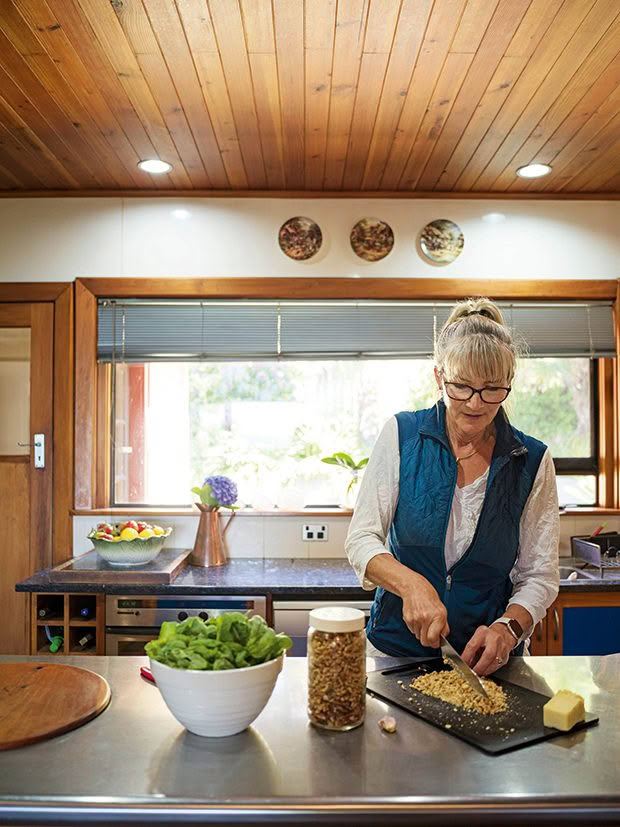
Antonia learned to cook initially on fishing boats in Alaska, but her morning-tea guests these days, often from visiting cruise liners moored in Picton, happily tuck into refined fare; cattle are an angus-cross; with no possums on the island, Antonia’s productive veggie garden is fenced for pūkeko and wind and supplies enough basil for to make hearty amounts of pesto; wiltshire sheep are self-shedders, as the price of strong wool is too low for shearing to be economical.
James (21) is a skilled fisherman, handy groundsman, diver, seaweed gatherer, cabin cleaner… to name a few of his daily pursuits.
Mike says he and Antonia value their children’s passion for island life and all aspects of the Radon operations on it — especially their relationship with the sea. And they love having them all home and wanting to live with them. “It is almost a religion to us, this deep-seated feeling about the fisheries and looking after all ocean species. The sea is unlike a coal mine or an oil well, where you exploit the resource until it is gone. If we take good care of the fisheries, everything will improve in 20 to 30 years. They could go on improving forever.”
GROWING PEARLS
In the wild, only one in 100,000 pāua might contain a pearl. Maybe. No one knows how often pāua spontaneously develop a pearl; they are
that rare.
Thousands of pāua in the Radon hatchery grow a pearl or two by laying down layers of distinctive blue-green nacre over a half-round disk in their shells. At four years old, pāua have two or more disks inserted into their outer shell, done with meticulous care to avoid nicking the haemophiliac creature and causing it to bleed to death. After another four years, the pāua will be harvested for meat, and the pearls retrieved.
The “blister” is extracted with a diamond saw by Fiona Bowler, one of the 50 people living permanently on the 75-square-kilometre island. Fiona works full-time with the Radons, mainly in the cutting room. Pearls are graded carefully under controlled light by a grader in colourless clothing.
- Blenheim jeweller Corey Broughton.
They are then logged and sent to jeweller Corey Broughton in Blenheim. Thanks to Fiona’s precision extraction and Antonia’s grading system, Corey says working with Arapawa Pearls is a pleasure. He says making jewellery is like engineering on a miniature scale. The pearls often dictate what jewellery they will become — teardrops, rings, pendants, earrings or speciality pieces. He and Antonia share ideas for the design of new items.
Arapawa Pearls are sold exclusively through Antonia’s on-site shop and her website. Book a trip to visit the Radons and their pearl farming operation at arapawabluepearls.co.nz.
WHAT THE RADON FAMILY GETS UP TO
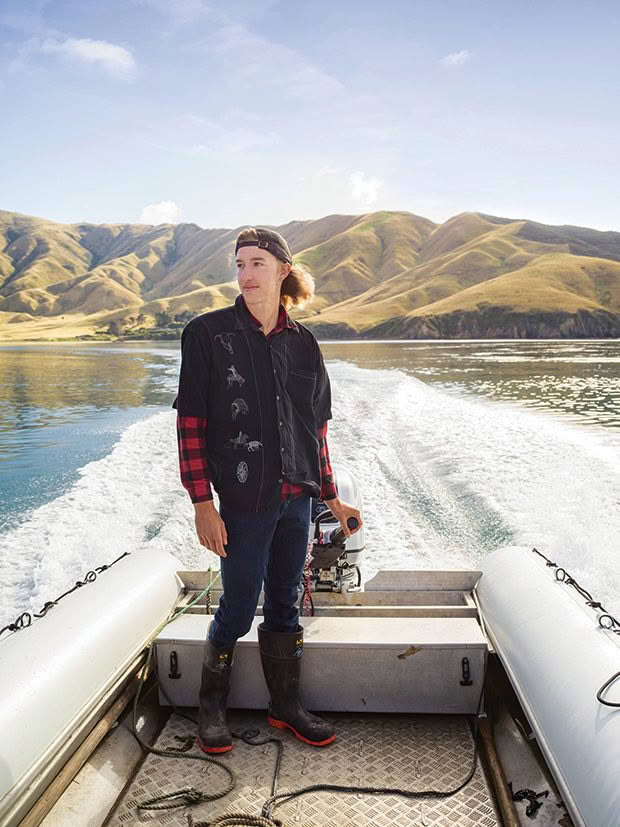
Pastoral farming: 283 hectares with 400 self-shedding wiltshire lambing ewes and 50 angus-cross beef cattle on Arapaoa Island in the outer Marlborough Sounds.
Forestry: 80 hectares in Pinus radiata that Mike wishes he’d never planted.
Commercial pāua catch: Two-tonne quota in Cook Strait and Kaikōura, supplying pāua meat directly to high-end restaurants.
Pāua hatchery: 30,000 live pāua grown from spawn to a shell size of 135mm and of which 10,000 approximately grow blue pearls.
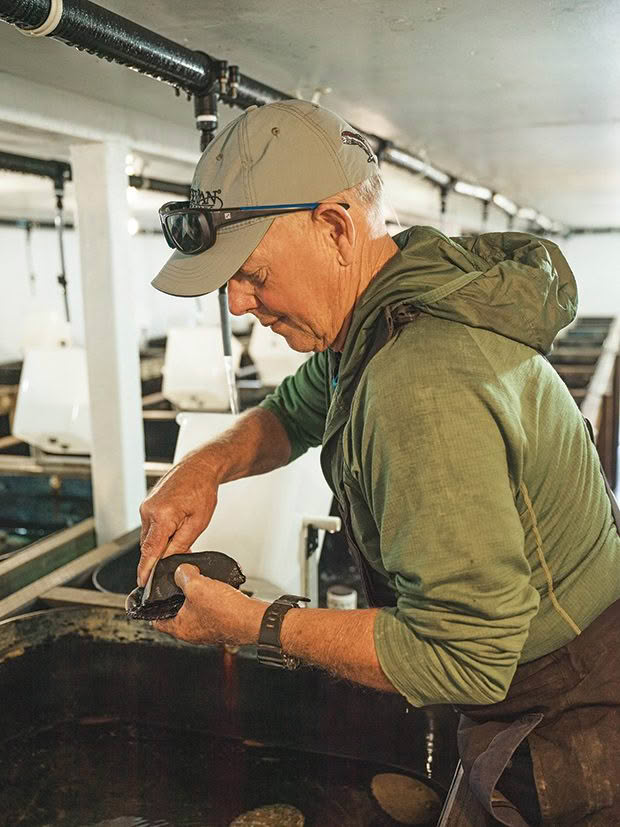
Seaweed: Regular collection of giant kelp to feed the pāua.
Jewellery: Mabe or blister pearls cultivated on-site are sent to Blenheim, where they’re made into jewellery.
Tourism and retailing: Hosting cruise ship tours with morning or afternoon tea, a hatchery tour and a visit to the shop in the old lighthouse keeper’s cabin close to Antonia’s vegetable garden.
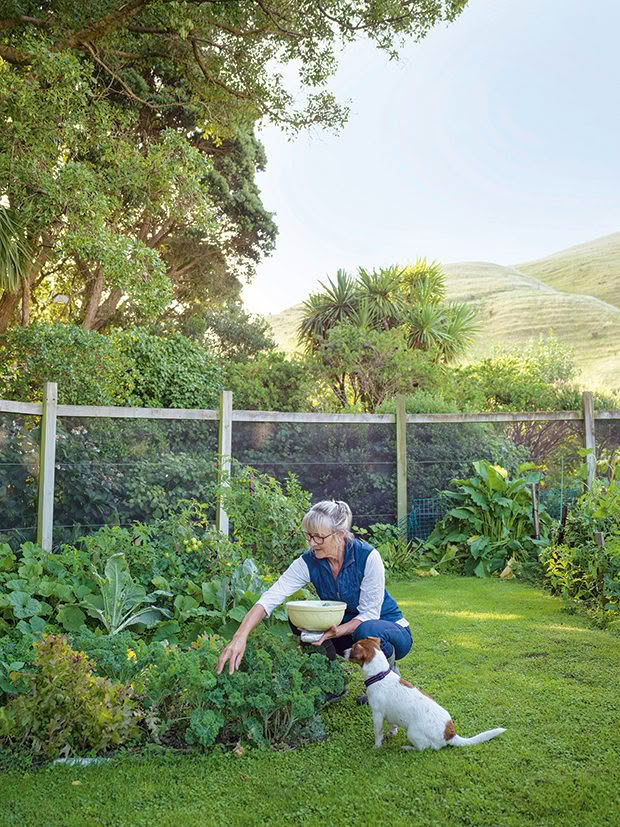
Operating three self-cater tourism options on the station: Gunyah, the Arapawa homestead built in 1945. Little Colonsay Beach house, built in the 1950s and once home to the local whaling station engineer. School Cottage, the original Whekenui Bay school building.
Salmon fishing: Chasing sockeye salmon each year in the largest salmon fishery in the world off the coast of Alaska, where the family owns two commercial boats (one is owned and skippered by Sarah). Every June and July, the Radons head to Dillingham, Alaska, to work the world’s largest runs of wild salmon in Nushagak Bay in the Bering Sea. Think bears and moose, cold weather and backbreaking manual labour.
Love this story? Subscribe now!
 This article first appeared in NZ Life & Leisure Magazine.
This article first appeared in NZ Life & Leisure Magazine.
